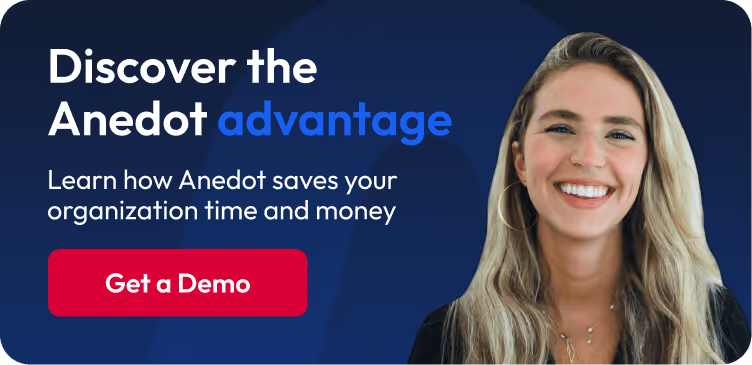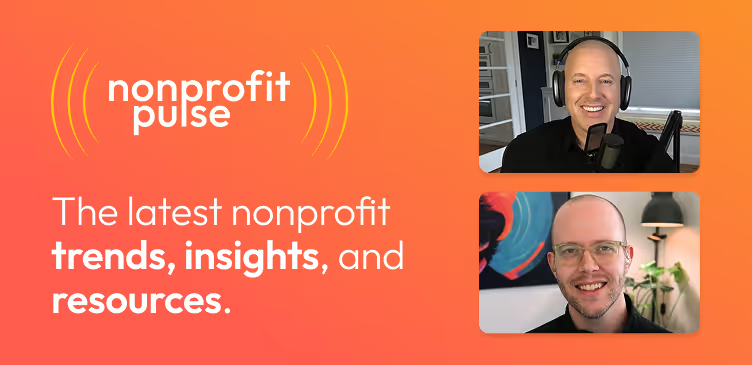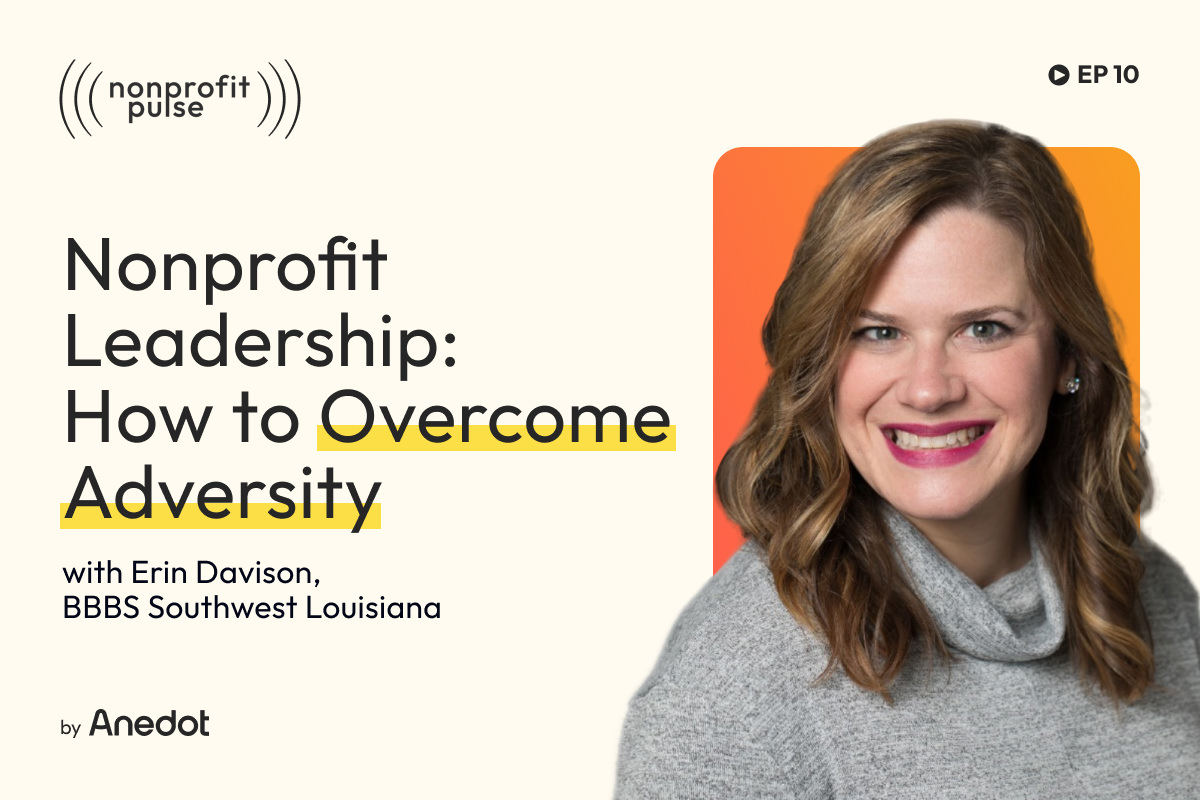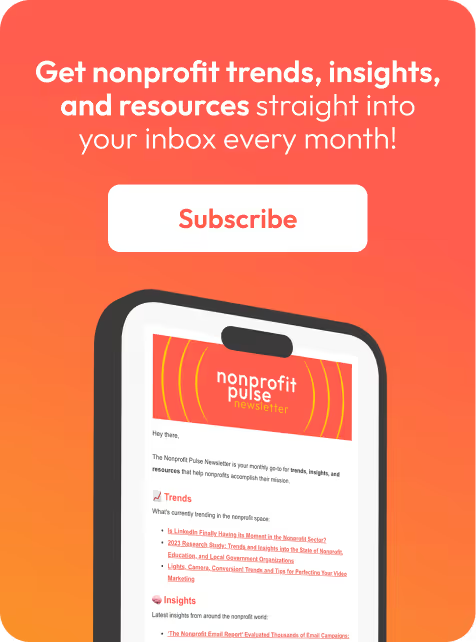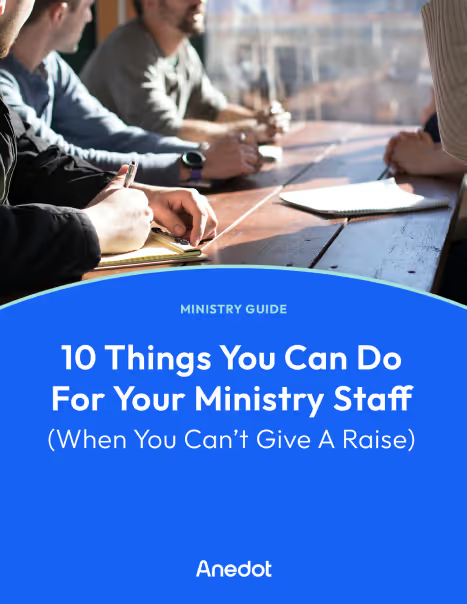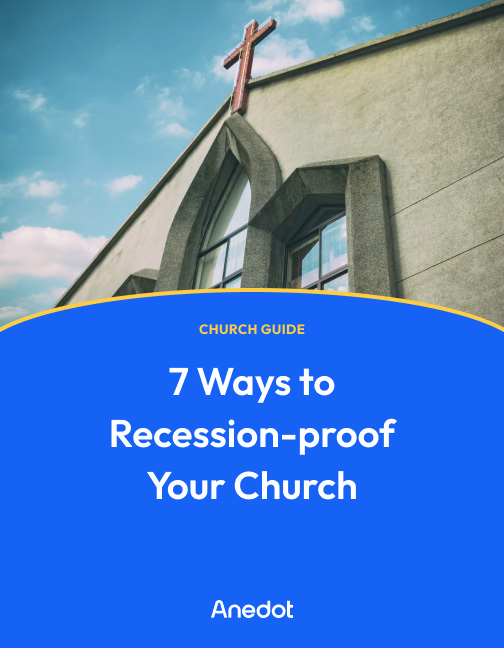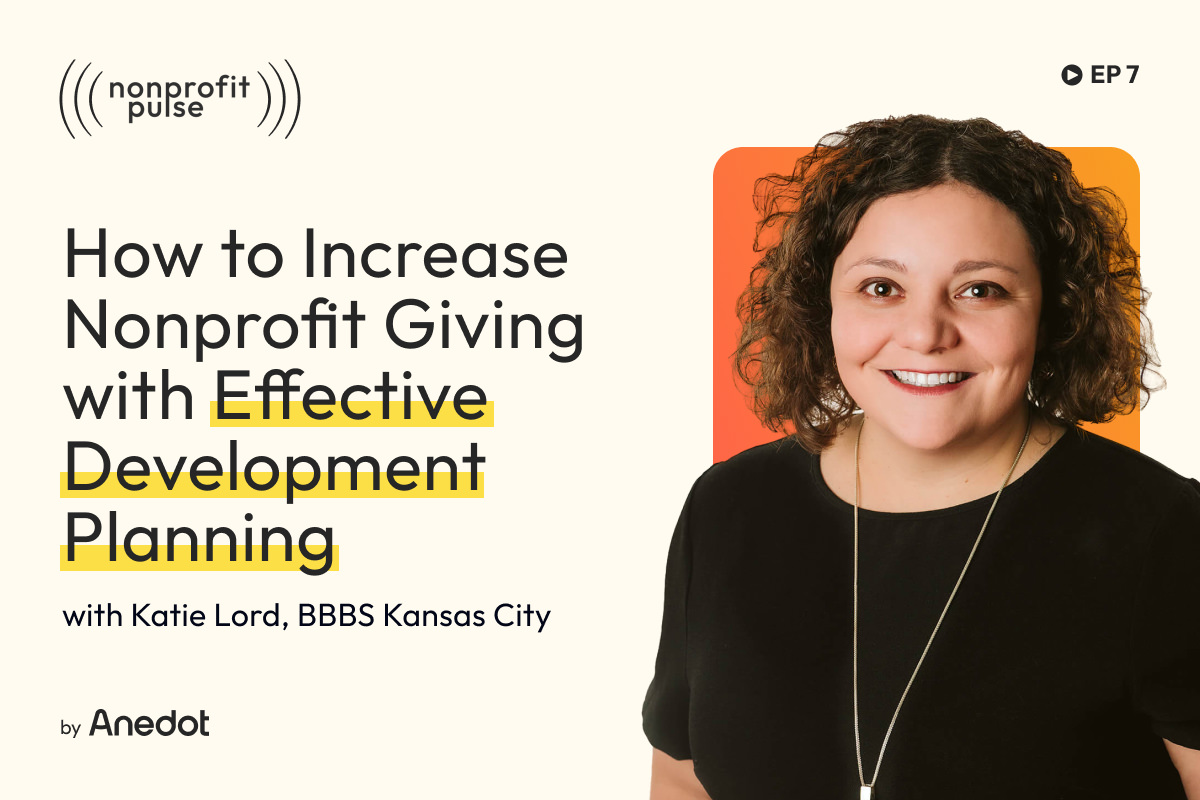Podcast episode transcript ↓
Josh:
Adversity is part of every meaningful endeavor. This is especially true in the nonprofit world.
So how can nonprofit leaders prepare for and overcome adversity while also facing the ever present challenges of nonprofit work?
I'm Josh with Anedot. Welcome to Nonprofit Pulse, where we explore trends, insights, and resources to help nonprofits accomplish their mission.
On this episode, we're joined by Erin Davison on the topic of preparing for and overcoming adversity as a nonprofit leader.
Erin is the CEO of Big Brothers Big Sisters of Southwest Louisiana where she has led her organization through multiple natural disasters, community evacuations, and a global pandemic.
Hey Erin, thanks so much for coming on Nonprofit Pulse.
Erin:
Thank you for having me.
Josh:
Yes. So today we're talking about adversity, overcoming adversity, and really how to thrive in the midst of adversity and not just be in the state of survival mode.
And, you know, thinking about adversity, if you've lived long enough, you know that it's really seemingly part of every human endeavor, every relationship, every work, every job, every organization you've served at, there's always adversity.
And you've got some really incredible stories of adversity.
Leading a nonprofit in Southwest Louisiana with just so many so many different natural disasters and challenges that are particular to your area, but also just challenges that all nonprofits face as well.
So before we kind of get to the overcoming adversity, maybe just share some challenges that you've faced in your many years of leading nonprofits.
Erin:
Gosh, there's so many challenges. How much time do you have?
No, it's like with adversity, I mean, everything that you do, whether it's your for profit or nonprofit, you know, business or company.
No matter what size you are, there's always going to be adversity.
Whether you have like internal adversity with staffing shortage or lack of resources, technology, trying to move with the world around you that's moving at warp speed.
Or there’s external challenges of do you fit a market need, you know, where is your business, where is your commodity?
And then when you live in the Gulf Coast region like we do, then you have a whole other unknown set of adversity when it comes to weather events or, you know, these catastrophes that happen that just we know they're coming. It's just when.
And so having that in your mindset of all of these little pieces of adversities that just kind of come together into one big snowball down an avalanche hill that just kind of makes you stop and think, okay, how can I at least prepare my reaction to adversities and best prepare for, you know, plan A, B, C, D, E all the alphabet letters and every other type of alphabet out there to plan sort of a framework around how to address adversity.
And so that's kind of where, as a seasoned leader comes in, is sometimes it's trial by error.
You know, you kind of you don't understand how you're going to react until you're actually in that predicament or situation to where you really have to just dive deep into your core and find out your asset, your strengths, and navigating through adversity.
Sometimes blindly, too. You know, sometimes you don't understand it, but you know, you have to do it.
How to overcome adversity in the wake of unforeseen challenges

Josh:
Yeah. So, maybe talk to us more about, y’all face some severe storms over the past several years.
Coincidentally, my wife is actually from where you live currently and that area. And so we know it just very well. And just some of the devastation.
And, you know, your nonprofit working with working with the public, working with children, with community leaders, you know, how have these hurricanes and natural disasters really put you on your heels at times when trying to do the good work that y'all are doing?
Erin:
Yes, I know. I call it the apocalypse because that's really the only nice word I can say in public to the community at large is the apocalypse, because it literally felt like the apocalypse.
You know, we had the pandemic. We've all struggled globally with the global pandemic. And, you know, we were all in that together trying to navigate in real time.
And then in August of 2020, Hurricane Laura, you know, just blew into southwest Louisiana and all of Louisiana, really. And that was a major hit directly to Lake Charles, Louisiana, which is in the heel of the boot. For those of you who are visualizing Louisiana.
And, you know, we're used to storms. We're used to, you know, very different types of weather events, and we've been impacted before.
But Hurricane Laura was just I mean, she was she could have been classified as a Cat 5. She was the largest storm in history to ever hit Louisiana directly.
And with that, I mean, when you're coming out of the pandemic, slowly awakening and, you know, June, July, early August of reopening step by step, trying to stay safe, you know, trying to have our matches, our bigs, littles families, my staff, board, community, I went into that mode of the pivoting part of it during the pandemic.
And then when the hurricane hit, everything literally flew out the window, figuratively and literally flew out the window. I mean, we you know, we have a disaster preparedness plan.
Every business, nonprofit or organization should have a disaster preparedness plan wherever you're located.
Have that, all those little steps for what you need to do to mobilize what you need.
But when Hurricane Laura hit, I had that plan. It was so outdated. When Hurricane Laura hit, I didn't follow a thing in that plan.
I'm like, then what's the point of having a plan? But there is a point.
And it was just, I went from nonprofit leader who is growing and reaching more youth wherever I can, to pivoting to being the seer, the oversighter of what's happening internally and externally with the organization.
And that was something I had never been prepared for, had never done in my career, of being so responsible for so many people and internally and externally. You know, you take the finances part of that.
Yes, we've struggled financially and all of that. But at that moment when I'm watching Hurricane Laura from the Weather Channel in a hotel room, that feeling that I did not think I was going to arrive back in Lake Charles with anything left.
And my thought immediately went to my people, you know, my families, because we have we serve a population that are considered ALICE families.
So they're Asset Limited, Income Constrained, Employed.
They’re the working poor. They’re the families that are working jobs after jobs. But they are right above the poverty threshold in our country. But they don't make enough money to make ends meet.
And so that next thought, I looked at my husband and I was like, what is this going to do to my families?
Like my families who maybe don't have insurance, or renting leasing property?
You know, they don't maybe they only have one car, maybe one of their family members stayed back at industry or maybe first responder and food and all of that rabbit hole thoughts just swirl.
And I just literally thought to myself, I can't change it. I mean, Hurricane Laura's blowing in, saw her in real time.
All I can do is go back home and when it's clear to go back home and start mitigating as much as possible. And nobody really prepares you for that.
Healthy egos help nonprofit leaders overcome adversity

Josh:
Yeah. Yeah, absolutely. And, you know, I love hearing, you know, just how nonprofit leaders find a way.
You know, I've heard it said before that, you know, with coaching, for instance, you know, winners find a way. And I feel like that's true with nonprofit leaders.
They find a way to overcome challenges. And it's also, it's often reaching down into their passion, you know, tenacity, grit, all these characteristics.
Maybe share with us how you've approached these challenges personally and how you've even had to grow and evolve as a leader through these challenges.
You know, as not all challenges are the same size, so to speak. But Hurricane Laura was was an incredible challenge.
You know, COVID was an incredible challenge. How do you today face challenges now, being a seasoned leader who's gone through those just immense challenges and adversity?
Erin:
I think it just stems from my inner core. I'm a middle child. I'm your typical middle child in my family, and I'm different from my older sister and younger brother.
And I've always just had this kind of I'm going to do it my way because nobody's paying attention to me because both my older sister and my younger brother were more stressful to my parents growing up than I was, so to speak.
And then I've always just been just eclectic with experiences and surrounding myself with very diverse individuals throughout my career.
And I'm curious about people and I'm curious about how people tick and how they, you know, learn. And I am a, you know, information junkie and read the books and listen to the podcasts.
It actually is exciting for me because I've actually watched and listened to yours before I even met you.
But I think it just stems from, you know, “if not me who” type thing.
And I also 12 years ago went through stage four cancer. And that moment in my life, I've always been strong. I've always had a cup half full type mentality.
You know, I like to see the good in everybody. It’s a struggle at times, there is some good I can find, but sometimes it's challenging.
But I think that journey for me just broke those chains of, you know, life is you get one chance, you get one chance in life. You get one chance and you don't get a lot of do overs.
And when you're a leader for a nonprofit in a rural community like we have, we're not in a large metropolis that you just know that it's a fight or flight.
And I've always been a fighter, you know, like, I tell everybody around me and I'm sure those that are listening are going to be like, oh my gosh, I can't believe she said that.
But if I'm going down with the Titanic, y'all are all coming down with me, you know? But I will be the first one to throw the life preservers.
I'll be the first one. I'll be the last one leaving that ship, you know. And that to me, is the integrity of a leader. It's who I admire in my mentors, you know, who I admire with my parents.
They're both leaders. And you know, who I rely on heavily to mentor me through the moments that I feel like I don't have it in me.
I don't know what to do. Nobody taught me this. There's not a rule book for this.
And it's just knowing that I can reach out and ask for help. I can reach out and say, okay, I'm tapping out.
What else can we do? And it's knowing you have a healthy ego as a leader, because we all do, but also not allowing that ego to rear its ugly head in a moment to where you need to surround yourself with the village.
And you are not the sole survivor on the island, basically. And that's humbling because we all want to feel, you know, I'm the leader, I’m the perfect decision maker, but I've taught myself to allow myself to say I don't know what to do and I need help, basically.
And even though I know it, it's in me and I know that I'm going to make a decision. But it's letting go of that fear of I'm making the wrong decision.
Because when you have to make snap decisions in a recovery period, regardless of that catastrophic event, you second guess yourself all the time. And that is that anxiety coming in that’s, if I make this decision, how is this going to affect this or that?
And in a moment's notice, you've just gotta let go of that fear and just know that you're in this position for a reason and you have it in you or you wouldn't be in this position.
And that you are going to make the best decision based on what you have at that moment. And then you just hope for the best and pray for, and pray the worst doesn't happen.
Two ways to overcome adversity as a nonprofit leader

Josh:
So you mentioned about, you know, surviving.
And you know, one of the things I wanted to discuss on this episode was the difference in surviving and thriving. And there's a big difference there.
So what would you say to our audience? You know, nonprofit leaders who are listening, who feel as though, man, I've got some intense adversity going on.
We've got revenue challenges, we've got volunteer challenges, staff challenges, even mission or vision challenges. And we're just merely surviving.
What would you encourage them with to move from that position of just surviving to actually thriving in the midst of adversity? Because, you know, let's face it, nonprofit life is full of adversity.
Erin:
Definitely. My two favorite things I say often is cash is king.
Anybody who takes a business 101 class or watches Shark Tank or anything else in this world, cash is king. And that is definitely true.
And then the second is don't give in to the fear.
Like we were just talking about. But that is that's so easy to do because we're human.
1. Cash is king
First of all, regardless of the size of your nonprofit, you have to put your company first, which means you should make it a priority to build a healthy reserve fund.
It's hard to do. It's hard for nonprofits because remember, we talked about that nonprofits sometimes have this perceived perception that they should not have a healthy reserve fund because you should not show a profit at the end of your fiscal or budget year.
That is false. Now, you shouldn't show a $3 million profit if your budget is a $100,000, but your profit goes back into your organization. Unlike a for profit company that pays it out in dividends.
So if you have a healthy organization, you will see a percentage of profit. You should designate part of that profit every year into your reserve fund, into your rainy day fund, whether it's $1,000 a year or whether it's $200,000 a year, that should be priority number one.
You should always strive to build cash assets, because if you don't have some sort of cash asset in a rainy day fund, you're never going to survive in any type of struggle, whether it's economic downfall.
You've got a major two or three major industries in your neighborhood that are closing and laying off 3,000 people. That's 3,000 donors. You're not going to recoup that money.
Whether it's the pandemic, it shouldn't matter why it should matter when. So that is the one thing I would say is build your rainy day fund.
You should have at least ten months of operating funds that you should strive for. Now, that takes a lot of work and it's a lot of sacrifice and it's a lot of conversations.
But over time you can do it. You can definitely do it.
2. Don't give in to the fear
And then two, don't give in to the fear.
We, especially as women in a leadership position, are still breaking those glass ceilings in a predominantly male leadership world.
Now, I'm not dogging men, don't, I'm not dogging men. But we do struggle still with our voice and still with giving in to that fear of I have to please my donors.
I have to please my funders. Yes, you do. But you please them in your delivery of your mission. That's how you please them.
And so if you're still able to fulfill your vision and mission, you may have to scale it down. You may have to close programs, you may have to consolidate staffing in a downturn. That's not your fault.
What you can do is still provide the service because during from March 2020 to 2022, that two year apocalypse for us, we still served our community and I was still transparent with my funders, donors, and investors.
And you should always increase organizational transparency.
Not all the bad stuff, you know, like all the nuts and bolts, but you should still feel the need to be transparent with your donors and your investors because they're supporting you financially and their finances are in a downturn. Or their revenue streams are impacted.
Donors are going to continue to give. They're going to give everywhere they want to give. You want them to give to you.
So that's when you really lean in and say, this is what's going on. We're still serving kids.
Rely on your impact, rely on that you are doing a service for your community and those donors and investors will continue to give.
And then quite a few of ours increased their giving because of those conversations, those hard conversations I was having with them.
Josh:
Yeah, they saw the need was still there and the funding was perhaps not there as much as previously.
And that's just super compelling and, just thinking through even just the details of your situation with all of the displacement of people from the hurricane to COVID to the job losses.
I mean, and your organization is so, you know, people oriented, I can't imagine just the logistics and the challenges of still fulfilling your mission and still doing programs.
Still, you know, creating partners, all the things that had to go on during during the apocalypse, as you mentioned, that must just been just an unbelievable time of learning and growth professionally and personally for you.
Make your organization a priority during times of adversity

Erin:
Yeah, I as a leader, I just, you know, worry about so many other parts. And during that time of, you know, Hurricane Laura completely devastated our building.
So we had to, okay now where do we go, where do we, where do I find a landing spot for us to be able to fulfill? And then there was flooding and then in May of 2021, we had a great flood.
Our temp office space flooded and okay, what are we going to do now?
And I just to me was like, you know what? I'm going to call on my people in my community and ask for at least a conference room that we could work remotely in and out of.
Because, one, it was important that my staff, my team could at least connect with each other face to face periodically because we all need human connection.
And one of the things I told right when the pandemic and the stay home order happened, I mobilized my board and I mobilized my team and I was like, nobody's leaving this organization.
We're not laying, I'm not laying off anybody. I'm not downsizing. We're doing none of that. So now we have to figure out how are we going to sustain and thrive through this pandemic, because there's things I will not negotiate and people are non-negotiable in my world.
And then when the hurricane hit, it was the same. So partnering with another sister affiliate, Lone Star out of Texas, they took over our programing health and safety checks for six weeks post-Hurricane Laura.
So my staff and I can mitigate personal issues and challenges. So every one of my bigs, littles board members, they were all accounted for. They were all checked in.
I was driving an hour and a half to work from my mother in law's house because that's where I could get wifi, you know. And then I was relaying information from Lone Star affiliate to my staff boots on the ground on who needed what help.
I mean, it was just basically recovery and then moving back into programing mode of, okay, you ask anybody who works with me, they'll say, well, Erin always says there's 26 letters in the alphabet and we're going to go through all 26 until we find a plan that sticks, you know, that works.
And it's just mobilizing and going back to the drawing board and being okay with saying anybody else have any ideas because I'm out.
Like my brain is tired, you know, but also knowing that there is light at the end of the tunnel, that there you will come out of whatever you're going through stronger if you just stay the course, believe in your organizational vision and mission.
Make your organization a priority, not internally. You make your organization a priority in your community.
You become a partner, you continue your partnerships, and then you just ask, you know, I sit down with so many different funders and they ask me what I need, what we need.
I tell them, I say, I, you know, we need $30,000 for this program or I need $5,000 to get hotspots for my staff to work from wherever they're working after a catastrophic hurricane.
You know, I need backpacks for my kids. I ask that. You ask me what I need, I’m going to tell you what I need. I'm not going to sugarcoat it, because there you know, that's that fear of, we can't, I can't say I need $1,000,000.
I'll tell you, if I need $1,000,000, you can just say no. You know, and then let's talk about it.
But I'm going to tell you why it's that why? Because they all need, they all know you need funding.
Closing thoughts

Josh:
I love that. I love that. And just the direct impact that they get to, they know where each dollar is going in their community.
It's just really a compelling ask, you know, when you can sit down and say, here's what, here's what's going to happen.
Here's what's going to change. Here’s who is going to be affected, if we can get this funding.
So I love that.
So Erin, imagine you're on stage in front of a thousand nonprofit leaders and you have the opportunity to say one sentence, one thing to those in the audience about thriving in the midst of adversity. What would you say?
Erin:
I would say, first thing, remember Phoenix rises from the ashes.
And the Phoenix, when they rise from the ashes, they don't rise in fear, they rise in confidence.
And cash is king. You have to start prioritizing how your revenue is used and definitely put some away for that rainy day.
Because I promise you that rainy days coming and it will.
And you have to at least try to be prepared to lean down your budget and stay the course with your mission, because every nonprofit's mission is extremely important in our world.
Josh:
I love that. Any resources you would recommend to our audience?
Erin:
Yes. So I've read a book, I went through life coaching back in 2022, and I was at a pivotal point in my career.
I was coming out of PTSD with all of the disasters. I second guessed myself. Am I still able to do my job? Am I still a fit for this role? And do I have, do I still have it in me to do this role effectively?
And a friend of mine, Jay, with Hayah Consulting, he said, let's do this. Let's get together. You got to do the work, but I'm going to give you some tools and resources to do it.
And that changed my course for the good because I realized I have everything in me that I need. I just needed to break it apart and pull it out piece by piece.
And so there's a book called The Mountain is You. And I did not want to read that book because I don't want to believe I am the problem. Okay?
But after reading it, it was like a light bulb. It was like, hey, Erin, you're the mountain, okay?
Like, you need to get your stuff together and figure out how you can stop being your own mountain, because we get into that woe is me.
I'm a nonprofit leader. I had to, have to exert, you know, show the community that we're out of money or show the community that, you know, give to us and we're a charity. That's factual.
But stop as a leader and think to yourself, am I the mountain here? Any part of that mountain?
And when I realized I was the problem, one, it made me mad, you know, my ego. But two, I was like, oh that's what's going on.
And then it gave me the tools and resources to help do the work to where when the mountain starts growing like the lava spews and starts growing a little creeping up, I know now what it looks like. And then I can just say, nope, no mountain.
It could be a molehill. Okay, I'm okay with a molehill, but I don't want to be a mountain again.
And so that's kind of that moment and that book, that one self-help book or leadership book that just resonated with me.
And I have shared that book with so many of my peers and friends and my staff because I'm like, I'll say, okay, you’re the mountain. Here, here's the book.
You got to fix your mountain. I’m the mountain expert now.
So but that. And also, just like I said earlier, like, just don't be scared to ask for help.
You know, you're not you're not you're not siloed on an island. You're part of a village.
And that village will tell you straight up honesty, but they're going to champion you as well. And we all need that sometimes.
Josh:
Erin, you're doing incredible work in southwest Louisiana and thanks so much for coming on and telling us your story.
I've just loved hearing it and loved how you've been used just mightily in your community.
And what you've been able to accomplish through your team and through the generous gifts of your community is so encouraging to hear nonprofit leaders come on the podcast and share what's going on in their communities.
So thanks so much for coming on the podcast.
Erin:
And thank you for having me. This was like, I'm like fangirling right now because I love this podcast for real.
I love this podcast. So thank you so much for having me.
And I hope I at least tried to help and provided some semblance of how to break your mountain down.
Josh:
This is why we do it is for leaders like you, and we hope to have many more leaders just like you come on and tell their stories and help other leaders out there who just need a word of encouragement or need some practical tips.
So, again, just thank you so much.
Erin:
Thank you.
Josh:
Hey, thanks for checking out this episode!
If you enjoyed it, please share it with others or leave us a rating and review.
To find show notes and resources mentioned in this episode, visit Nonprofitpulse.com.
There, you can also sign up for the Nonprofit Pulse monthly newsletter where we send the latest trends, insights, and resources to help nonprofits accomplish their mission.
We'll see you next time.
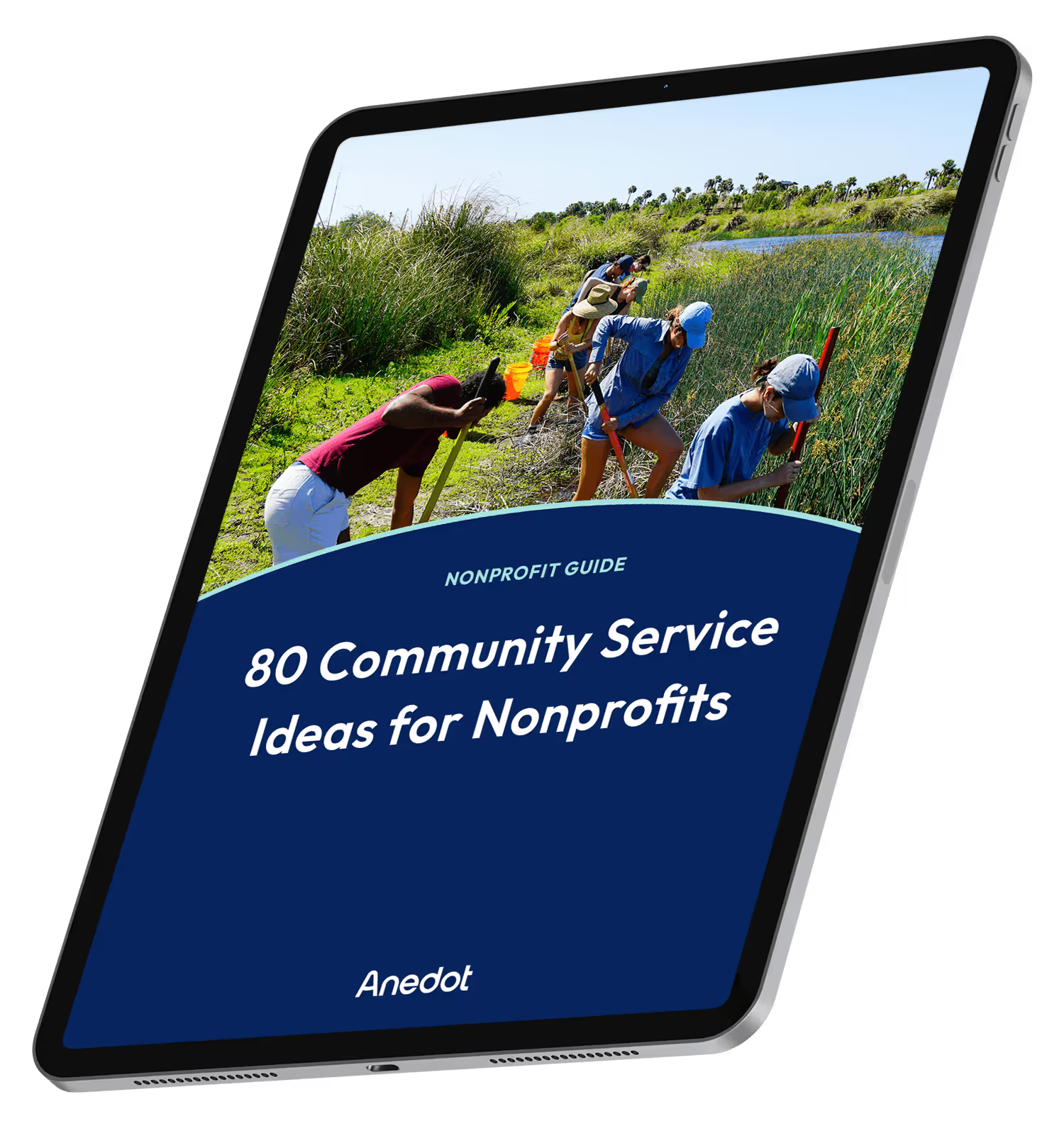
80 Community Service Ideas for Nonprofits
